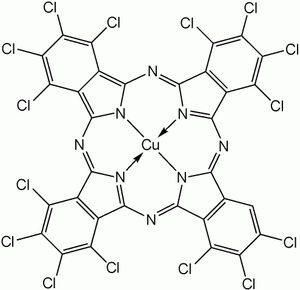Phthalocyanine Green G
Phthalocyanine Green G (with many commercial names) is a synthetic green pigment of a phthalocyanine dye, which is a complex of copper (II) and chlorinated phthalocyanine. It is a soft green powder and is insoluble in water. It is a bright, high-intensity color used in oily and acrylic artist paints and other applications.
 Figure 1. Structure of Phthalocyanine Green G.
Figure 1. Structure of Phthalocyanine Green G.
Synthesis, properties and production
Phthalocyanine green is derived from phthalocyanine blue by chlorination in the presence of aluminum trichloride. Shows the stoichiometry of complete chlorination:
Cu(C32H16N8) + 16Cl2→Cu(C32N8Cl16)+16HCl
In fact, this pigment is a mixture of isomers and degrees of chloride. The 15th and 16th chlorides are difficult to install. The chemical formula is usually C32H3Cl13CuN8 to C32HCl15CuN8.
Due to the presence of strongly electronegative chlorine substituents, the absorption spectrum is different from that of the parent copper phthalocyanine. Phthalate green is very stable and resistant to alkali, acids, solvents, heat and ultraviolet radiation.
Applications
Due to its stability, phthalocyanine green can be used in inks, coatings and many plastics. It is transparent in the application. Because it is insoluble, there is no tendency to migrate in the material. It is a standard pigment used in the printing ink and packaging industries. Except for eye makeup, all cosmetics are allowed.
Reference:
- Wojdyla, Michal.; et al. Lock-in phase analysis of copper phthalocyanine photoabsorption spectrum. Optica Applicata. 2005, 35 (3): 561–571.
Resources

- Hoechst Dyes: Definition, Structure, Mechanism and Applications
- Mastering the Spectrum: A Comprehensive Guide to Cy3 and Cy5 Dyes
- Fluorescent Probes: Definition, Structure, Types and Application
- Fluorescent Dyes: Definition, Mechanism, Types and Application
- Coumarin Dyes: Definition, Structure, Benefits, Synthesis and Uses
- BODIPY Dyes: Definition, Structure, Synthesis and Uses
- Cyanine Dyes: Definition, Structure, Types and Uses
- Fluorescein Dyes: Definition, Structure, Synthesis and Uses
- Rhodamine Dyes: Definition, Structure, Uses, Excitation and Emission
- Unlocking the Power of Fluorescence Imaging: A Comprehensive Guide
- Cell Imaging: Definitions, Systems, Protocols, Dyes, and Applications
- Lipid Staining: Definition, Principles, Methods, Dyes, and Uses
- Flow Cytometry: Definition, Principles, Protocols, Dyes, and Uses
- Nucleic Acid Staining: Definition, Principles, Dyes, Procedures, and Uses
- DNA Staining: Definition, Procedures, Benefits, Dyes and Uses
- Cell Staining: Definition, Principles, Protocols, Dyes, and Uses
- Ion Imaging: Definition, Principles, Benefits, Dyes, and Uses
- Fluorescent Labeling: Definition, Principles, Types and Applications
Online Inquiry



